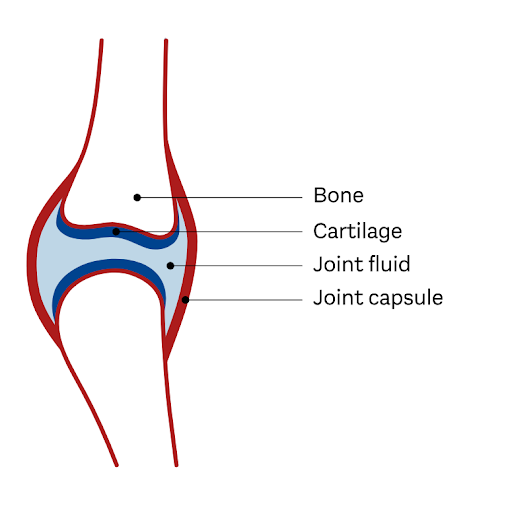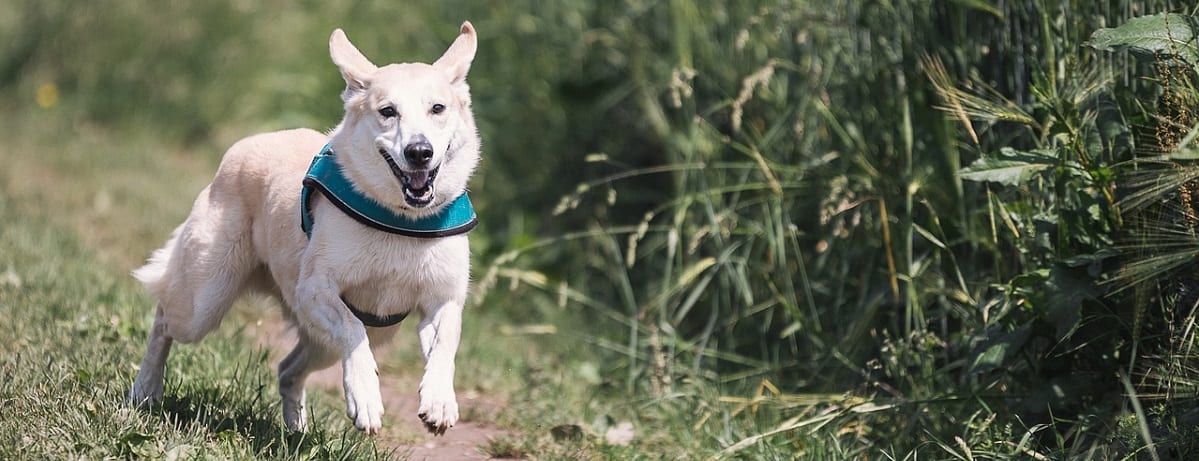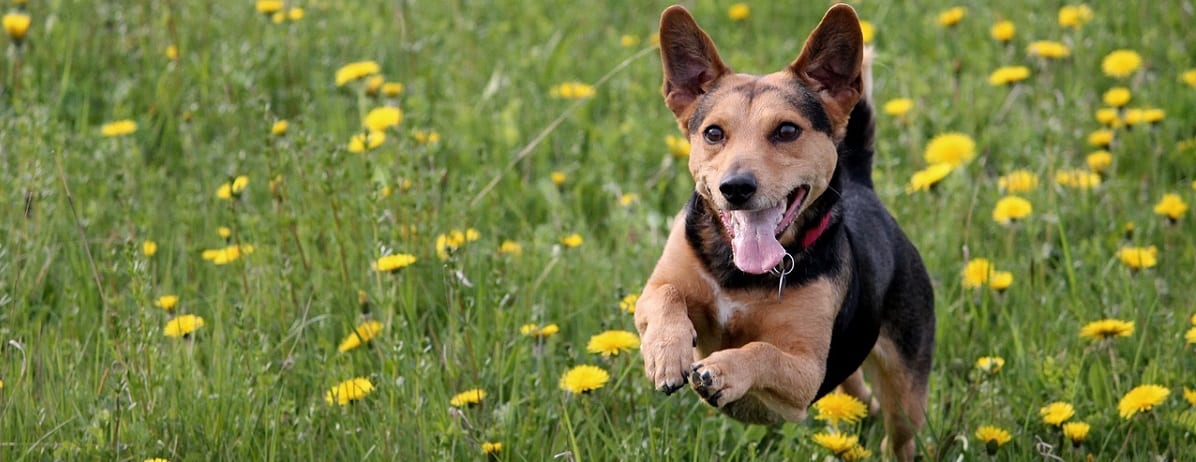Updated Aug 27, 2025
As a dog owner, have you ever witnessed a senior dog struggling to stand up, using only its front paws to ease the discomfort on its back legs? This is a classic sign of hip dysplasia, and it’s only one of many joint issues dogs can experience. Joint pain, osteoarthritis, dysplasia, and osteochondrosis dissecans are all serious joint health issues that need to be handled promptly to prevent pain and further joint damage. Otherwise, the pain can become unbearable, and dogs will lose their desire to play, go on walks, or even greet you at the door-an act so sacred in our hearts we can’t imagine a day without it.
Here we’ll share the importance of dog joint health and how to protect it.
Joint Breakdown: What Constitutes a Joint?
There are a few basic components of a joint, each with its own function to play.

Connecting bones – Joints are spaces between bones. The bones make up the structure of the joint. How they’re shaped when the dog is developing determines the joint’s integrity and stability.
Joint Cartilage – Cartilage is the firm connective tissue between bones that cushions the bones and joints during motion. When healthy cartilage is damaged or worn away, the bones collide, causing severe pain and inflammation.
- Synovium and synovial fluid – Synovial fluid is the collection of fluid within the joint that lubricates and provides nutrients for the structures within the joint. It is produced by joint tissue called synovium. Synovial fluid lubricates the bones and cartilage, allowing for painless joint motion. Too little or too much fluid within the joint leads to cartilage damage and arthritis follows.
- Ligaments – Ligaments are connective fibers along the joints. These attach from bone to bone and contribute to joint stability.
Why Joints are Important
Joints are what allow dogs (and us) to move freely. Joints provide stability and motion for the body. The skull protects the brain and the ribcage protects the heart and lungs. Joint pain is a common complaint about elderly dogs. Joint pain can keep dogs from moving freely, resting, playing, and even eating. Over time, this discomfort may affect their mood and energy, making life harder for them and their families. Once the cartilage is damaged, repairing the joint can be difficult. The importance of dog joint health cannot be overstated.
Developmental or Degenerative: Joint Disease Categories
Joint disease typically falls under one of two categories: developmental or degenerative. Developmental joint issues come from either the overdevelopment or underdevelopment of the joint structures. Hip sockets, for example, may develop abnormally with loose joint capsules and rapid bone growth, resulting in inflammatory, arthritic bone changes, and luxation of the joint in some cases.6 This constant friction is what causes hip dysplasia as the dog ages.6 Many large breed dogs inherit an increased risk for hip dysplasia.6
The other type of joint problem is degenerative joint disease (DJD). DJD, also called osteoarthritis, is the most common cause of arthritis in dogs. It is irreversible joint damage characterized by cartilage damage, bony growths within the joint, and fibrosis.5 Older dogs are prone to DJD, but even younger dogs may develop it due to trauma, injury, or developmental disorders.5
Signs and Symptoms of Joint Problems
Because of the constant pain associated with DJD, dogs have a hard time hiding dog arthritis symptoms. Even a halfway attentive owner will notice one of the many signs and symptoms of joint problems:
- Limping or favoring one side – Dogs with joint issues may limp or favor one side over the other. They do this to keep the weight off their affected joint to relieve pain.
- Standing with only front legs – Hip dysplasia can be spotted when your dog stands up-they’ll only use their front legs. This is to avoid putting pressure on the hind legs and hips. It could also be a sign of problems with the joints of the spine.
- Refusal to jump or climb stairs – Jumping and climbing are stressful activities on joints. If your dog suddenly looks at a San Francisco-esque hill, and then gives you that “you’ve got to be kidding me” look, you’ll know it’s time to visit the vet.
- Swollen joints – Inflammation within the joint may be visible as a swollen area around the joint. Addressing this early can prevent further damage.
- Muscle degeneration – Dogs protect the painful joint by displacing their weight to other legs, leading to muscle atrophy around the affected joint.
- Licking the affected joint – Dogs may lick the soft tissues around the affected joint in an attempt to relieve the pain.
- Changes in temperament – Being greeted by our tail-wagging friend after a long day is always a treat. But when our furry companion develops chronic joint pain, this joyful greeting can suddenly become a thing of the past. Dogs with joint pain may act depressed, lethargic, and uninterested in normal activities.

Diagnosing and Treating Joint Pain
If your dog is acting strange, and you believe it is caused by their joints, visit your local veterinarian for advice. Certain joint disorders can be resolved, allowing your dog to live a relatively pain-free life. However, this often depends on how early the joint issue is identified and treated.
PROCESS OF DIAGNOSING
The veterinarian has a number of strategies to identify joint problems and their underlying causes.
- Physical examination – By watching your dog move, and stretching and flexing different muscle groups, vets can identify which joint is affected and to what degree.
- Synovial fluid Sample – By withdrawing and analyzing the fluid inside the joint, vets can determine if an infectious disease or other problem is occurring.
- Bloodwork – Blood tests for immune-mediated disease or tick-borne disease may also be done.
Treatment: Medical or Surgical?
Treatment cannot cure DJD but it can slow the progression and minimize pain. Making changes at home such as using non-slip mats under rugs and installing ramps help.5
Adipose tissue releases inflammatory factors that make DJD worse so weight reduction is necessary for overweight dogs with DJD. Low impact and no impact activities like walking and treadmill exercise can help reduce weight and build muscle mass without exacerbating joint pain.
Therapeutic options including agents that protect cartilage, stimulate synovial fluid production, lubricate joints, and reduce inflammatory factors may be recommended by your veterinarian.
Non-steroidal anti-inflammatory medications (NSAIDS) are central to DJD pain management. However, your veterinarian will discuss the potential side effects of NSAIDs to watch for. Other pain medications may be recommended.
Acupuncture and physical therapy may also be beneficial. Surgical intervention is discussed when medication no longer controls DJD symptoms. Surgical correction of the underlying trauma or developmental problem can prevent further damage in the joint and reduce DJD symptoms. The type of surgery recommended depends on the joint involved.

Improving Joint Health for Dogs
There are a few different techniques to improve joint health for dogs. Some involve relieving joint stress. Others target the muscle groups around the joints to improve flexibility and to provide load-bearing assistance. A combination of the two is your best bet for improving your dog’s joints.
When targeting the stress and pressure on joints, you can:
- Keep your dog lean – Obesity and being overweight stress joints.
- Improve their diet – A healthy diet means healthy gut biome, weight, and joints. Combining healthy ingredients and a dietary supplement is a great way to improve your dog’s quality of life and keep their joints strong.
- Low impact exercises – Unfortunately, if your dog is diagnosed with arthritis, it might mean that fetch is off the table. High impact activities like running, jumping, and catching will be painful. Low impact exercises are a great way to keep your dog active and reduce their pain.
- Walking – Who doesn’t love a good walk? It’s low-impact, relaxing, and great for the mind (yours and your dogs). Building a walk into your daily routine helps keep dogs moving and happy with less pain.
- Swimming – Swimming is a fun, low-impact exercise that’s perfect for dogs with joint problems. Be sure their entrance and exit from the water is flat and has good traction.
- Indoor games – Because most outdoor games involve high-impact running, switch to indoor games for dogs with DJD. Teach your dog to find toys using their excellent sense of smell. A little game of hide and seek will be a welcomed surprise for your dog.
- Trick training – Dogs crave mental stimulation. Learning new tricks and words stimulates their mind, and creates a stronger bond with you. Research shows that some dogs can learn up to 250 words.2
- Hiking – Yes, yes, this is just an iteration of walking. But walking typically means routine smells and the same spots. While dogs do love this, a switch-up now and again to a new world, such as a hiking trail, will do wonders for your dog’s mental health. Be sure the trail is flat and has smooth, soft ground.
- Ramps instead of stairs – Use ramps to help your dog go up and down steps, get on the bed, or get in and out of the car.
When targeting the muscle groups around the joint, you can:
- Help your dog stretch – When your dog is calm and lying down, you can coax them into a few stretching exercises. Have your veterinarian show you what stretches are beneficial for the affected joints. Have treats ready. This way, your dog will enjoy stretching time and be more willing to let you do it.
- Strengthening exercises – Swimming and underwater treadmill therapy help build muscle around arthritic joints.

Joint Supplements for Dog Health
Many joint supplements focus on lubrication. While lubrication is crucial, supplements should also help prevent damage in the first place. Joint supplements, like Vetericyn’s All-In Supplements, are a smart choice, helping to protect against further wear and tear while supporting comfort and healthy joint function.
Living With a Joint Disease
Joints are unique structures. They require special attention and care. The best option for joint health is protection and prevention. Ensuring your dog has a healthy lifestyle can prevent chronic joint pain later in life.
However, if your dog is experiencing some form of arthritis or degenerative joint disease, consult your veterinarian and know that there are options available. Vetericyn offers effective, targeted, holistic care so you can give your dog the best chance to live a happy, healthy life.
 Reviewed by Dr. Kathy Adamson
Reviewed by Dr. Kathy Adamson
Dr. Kathy Adamson earned her bachelor’s degree from the University of Notre Dame and her Doctor of Veterinary Medicine degree from the University of Wisconsin-Madison School of Veterinary Medicine.
She completed a one-year small animal medicine and surgery internship at the North Carolina State College of Veterinary Medicine. Alongside her studies, Kathy worked in a research lab, contributing as an author and co-author to various journal articles.
She has also pursued medical writing and editing certification through the University of Chicago Graham School. Currently, she runs KMA Veterinary & Medical Writing, a freelance medical writing company, serves as the Digital Content Manager for the Greater Chicago Area Chapter of the American Medical Writers Association, is a member of the AMWA Communications Committee, and enjoys writing about healthcare topics for people and their cherished pets.
![]() https://www.linkedin.com/in/kathyadamsondvm/
https://www.linkedin.com/in/kathyadamsondvm/
Sources:
- Pets Web MD. Dog Joint Health: Pain, Osteoarthritis, and Other Joint Problems. https://pets.webmd.com/dogs/guide/dog-joint-health-pain-osteoarthritis-and-other-joint-problems#1
- Petful. How Many Words Can a Dog Understand? https://www.petful.com/behaviors/how-many-words-can-dog-understand/
- PetMD. How to Treat Arthritis and Joint Pain in Dogs. https://m.petmd.com/dog/general-health/evr_dg_remedies_for_arthritis_in_dogs
- PetMD. Green Lipped Mussels for Dogs: How They Can Help. https://www.petmd.com/dog/wellness/green-lipped-mussels-dogs-how-they-can-help
- Veterinary Information Network. Degenerative Joint Disease (Canine). https://www.vin.com/members/cms/project/defaultadv1.aspx?pid=607&id=4953600. Accessed August 26, 2025.
- Harari J. Hip Dysplasia in Dogs. Merck Veterinary Manual website. https://www.merckvetmanual.com/musculoskeletal-system/arthropathies-and-related-disorders-in-small-animals/hip-dysplasia-in-dogs. Published 2025. Accessed August 26, 2025.
